
Genrobotics: Scaling up while cleaning up
The Kerala-based robotics startup, which began with machines to clean sewers, is growing in size and scope while doing social good
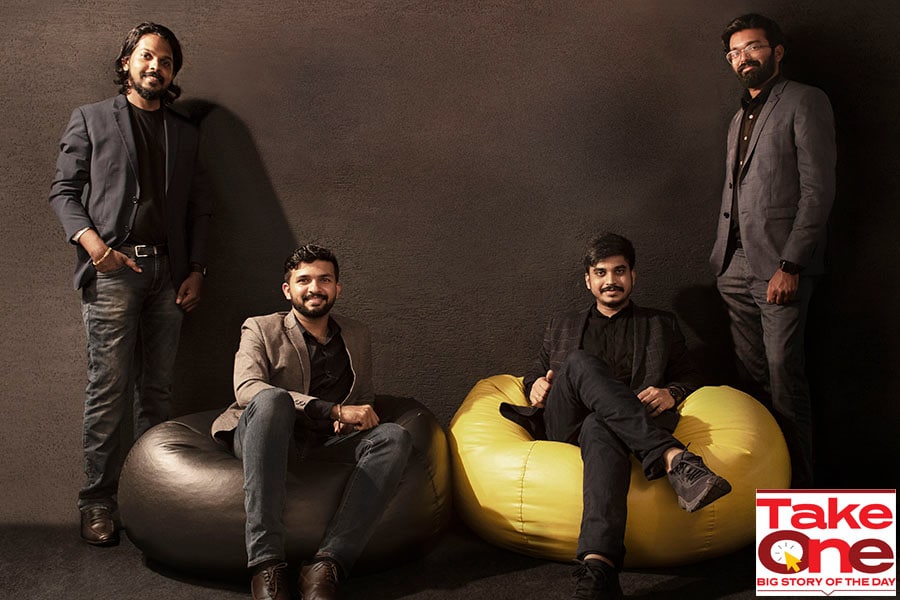 (From left) Arun George, Rashid K, Vimal Govind MK and Nikhil NP, co-founders, Genrobotics
(From left) Arun George, Rashid K, Vimal Govind MK and Nikhil NP, co-founders, Genrobotics
Nearly two decades ago, as a sanitation worker for the Indore Municipal Corporation, Govind Bherve would routinely lower himself into manholes, and clean the sludge and muck out with his hands. Often, he’d say a silent prayer before jumping in, for he didn’t know if a reptile or a rodent would be lurking inside; during work, he was dunked in filthy sewage water gushing out of the pipes. “We spent close to 30 minutes inside a manhole every day, and continued with our 8-10 hour shifts thereafter,” says Bherve, now 35. “It was so dirty that I got skin infections regularly.”
Even outside work hours, Bherve was called to attend emergencies, say, when a plumbing line choked at midnight. “We’d just take off our clothes and go into the manhole,” he says. “Protective suits the, par usme dum ghut ta tha [there were protective suits, but they would suffocate us].”
Bherve still works as a sewage worker with the municipal corporation, but his life has taken a U-turn. For some time now, he hasn’t set foot inside a manhole; instead he operates a robot that opens the manhole cover, goes deep into it and scoops out the sewage with its multi-functioning arm, just like a human. “There’s a screen attached to the external unit that shows us the nature of garbage inside, helping us manoeuvre the arm efficiently; it also detects if there’s noxious gas inside,” he says. “This robot has made our lives so much easier.”
Christened Bandicoot, the robotic scavenger that has brought Bherve such joy is the brainchild of four engineers—Arun George, Nikhil NP, Rashid K, and Vimal Govind MK—from Kerala, who seeded the idea in 2015, while studying in MES College of Engineering, Kuttippuram, in Malappuram district.
It started with designing for the college project a first-generation powered exoskeleton, a wearable mobile machine called the Iron Man suit, that could lift weights and facilitate military supplies in remote areas; a fine-tuned version the following year was put together to help amputees walk, and a paper on it won the best concept award at the International Conference on Mechatronics and Manufacturing held in Singapore.




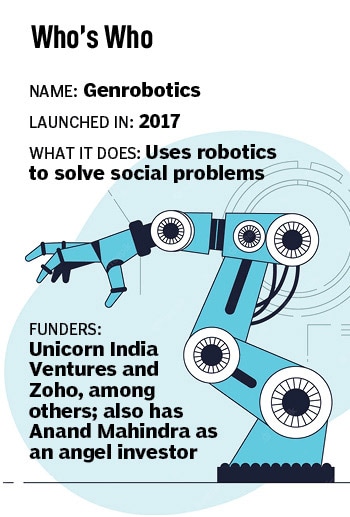 While Genrobotics has been steadfast in their focus on social good, its financials have also chimed in, with revenues climbing from Rs 25.6 lakh in FY18 to Rs 12.73 crore in FY21, as per financials database Tofler. During this period, it has not only managed to wipe out a loss of Rs 1.71 lakh it incurred in FY18, the first year of operations, it ended FY21 with a profit of Rs 3.71 crore. The company has raised investments from venture capitalists (VCs) like Unicorn India Ventures and SaaS major Zoho, and also counts industrialist
While Genrobotics has been steadfast in their focus on social good, its financials have also chimed in, with revenues climbing from Rs 25.6 lakh in FY18 to Rs 12.73 crore in FY21, as per financials database Tofler. During this period, it has not only managed to wipe out a loss of Rs 1.71 lakh it incurred in FY18, the first year of operations, it ended FY21 with a profit of Rs 3.71 crore. The company has raised investments from venture capitalists (VCs) like Unicorn India Ventures and SaaS major Zoho, and also counts industrialist 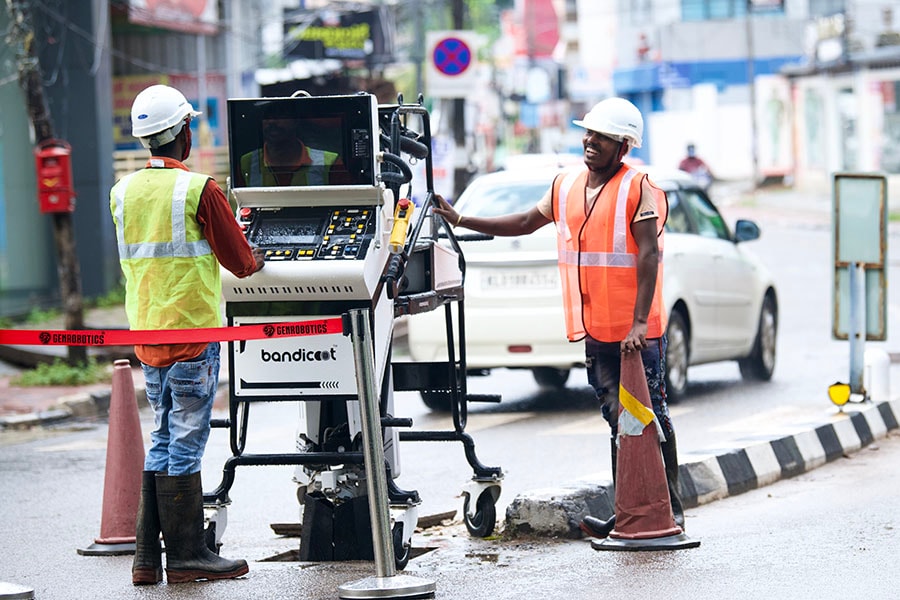
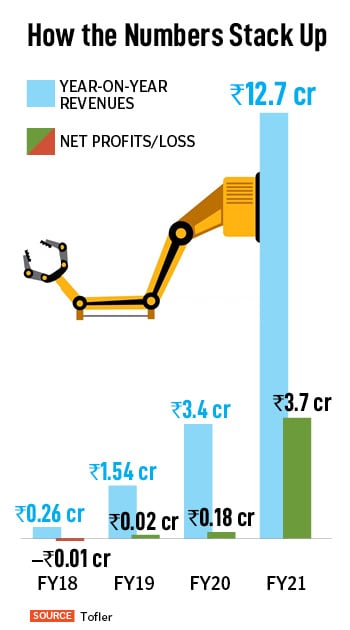 It has rolled out two more products into the market: Willboar, to clean large tanks in sanitation, oil and gas and chemical industries, and G-Gaiter, a medical robotic gait trainer that helps paraplegics (who suffer from spinal cord injuries or medical conditions like strokes, cerebral palsy) undergoing neuro rehabilitation regain some of their limb movements. “The exoskeleton we built in college had multiple applications, especially in the medical industry. But it required a lot more R&D and funding than Bandicoot,” says Vimal. “Once we started earning profits, we channelised those here.”
It has rolled out two more products into the market: Willboar, to clean large tanks in sanitation, oil and gas and chemical industries, and G-Gaiter, a medical robotic gait trainer that helps paraplegics (who suffer from spinal cord injuries or medical conditions like strokes, cerebral palsy) undergoing neuro rehabilitation regain some of their limb movements. “The exoskeleton we built in college had multiple applications, especially in the medical industry. But it required a lot more R&D and funding than Bandicoot,” says Vimal. “Once we started earning profits, we channelised those here.” 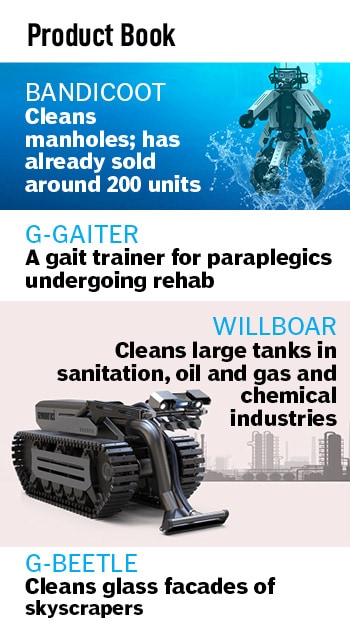 Of its 200-odd staff, up from the nine they started with, Genrobotics has deployed about one-fifth towards R&D, a function that has impressed Zoho, which recently invested Rs 20 crore in the company. CEO and co-founder Sridhar Vembu told Forbes India in an email: “It is important to have technological knowhow and capabilities if we have to make India globally competitive. We ourselves have built our technology through relentless focus on R&D over the past 26 years. We see that in Genrobotics as well. Besides, one of our core values is to serve the underserved; we share that with Genrobotics as they are on a mission to eradicate manual scavenging.”
Of its 200-odd staff, up from the nine they started with, Genrobotics has deployed about one-fifth towards R&D, a function that has impressed Zoho, which recently invested Rs 20 crore in the company. CEO and co-founder Sridhar Vembu told Forbes India in an email: “It is important to have technological knowhow and capabilities if we have to make India globally competitive. We ourselves have built our technology through relentless focus on R&D over the past 26 years. We see that in Genrobotics as well. Besides, one of our core values is to serve the underserved; we share that with Genrobotics as they are on a mission to eradicate manual scavenging.”




